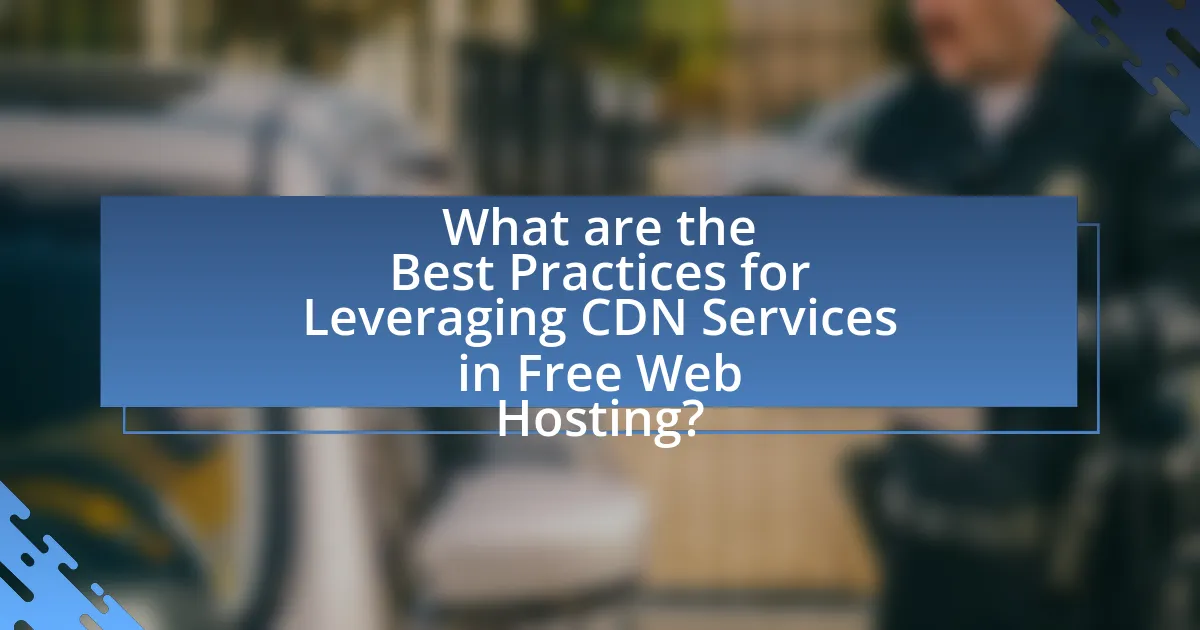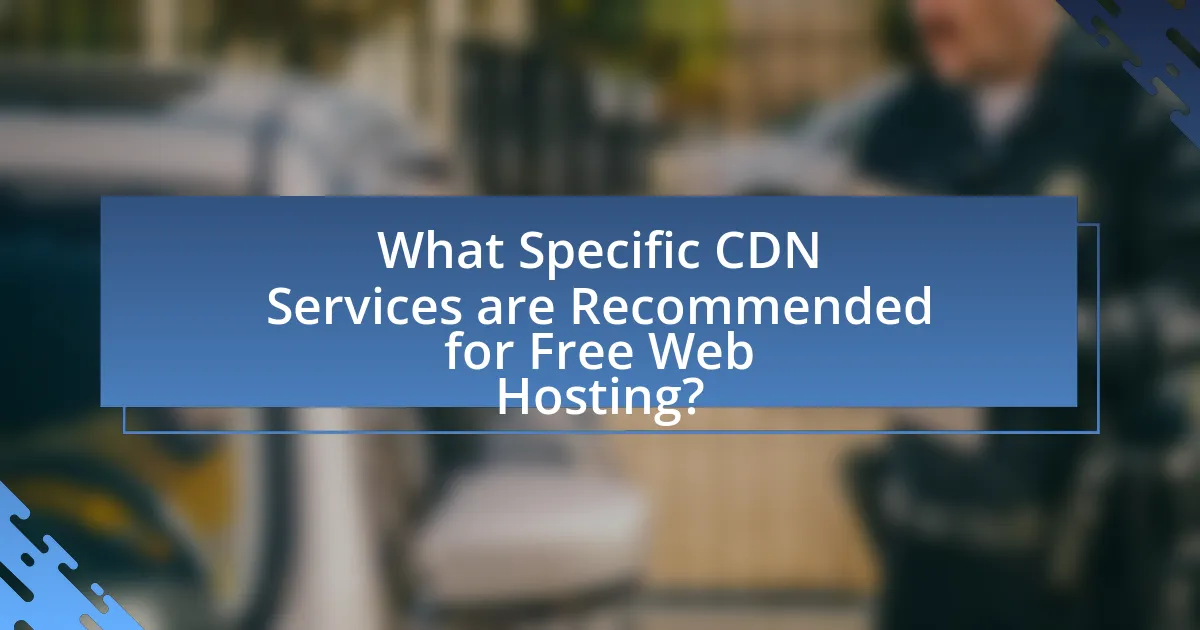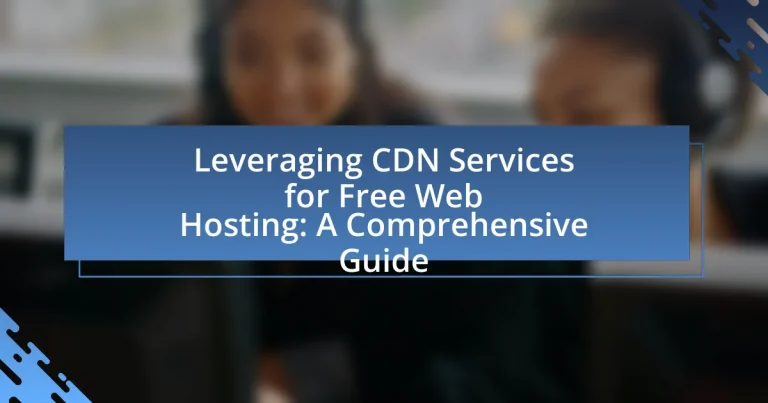CDN services, or Content Delivery Network services, are essential systems that enhance the speed and reliability of web content delivery by distributing it across multiple geographically dispersed servers. This article provides a comprehensive guide on how CDN services can significantly improve the performance of free web hosting solutions, addressing key components of CDNs, their advantages, and best practices for integration. It also discusses potential challenges and limitations associated with using CDNs in conjunction with free hosting, while recommending specific CDN providers that offer free or low-cost services. By leveraging CDN services, users can optimize website performance, reduce load times, and enhance overall user experience, making it a valuable strategy for those utilizing free web hosting platforms.

What are CDN Services and How Do They Relate to Free Web Hosting?
CDN services, or Content Delivery Network services, are systems that distribute content across multiple servers located in various geographical locations to enhance the speed and reliability of delivering web content to users. These services relate to free web hosting by providing an efficient way to improve website performance without incurring additional costs, as many free web hosting providers offer integrated CDN options. For instance, using a CDN can significantly reduce latency and load times, which is crucial for user experience, especially when free hosting may have limitations in bandwidth and server resources. Studies show that websites utilizing CDN services can experience up to a 50% reduction in load times, making them a valuable asset for users relying on free hosting solutions.
What is a Content Delivery Network (CDN)?
A Content Delivery Network (CDN) is a system of distributed servers that deliver web content to users based on their geographic location. CDNs enhance the speed and reliability of content delivery by caching copies of content at multiple locations around the world, which reduces latency and improves load times. According to a study by Akamai, using a CDN can decrease page load times by up to 50%, significantly enhancing user experience and engagement.
How does a CDN improve website performance?
A Content Delivery Network (CDN) improves website performance by distributing content across multiple servers located in various geographical locations. This distribution reduces latency, as users can access data from a server that is closer to them, leading to faster load times. For instance, studies have shown that using a CDN can decrease page load times by up to 50%, significantly enhancing user experience and engagement. Additionally, CDNs optimize bandwidth usage and reduce the load on the origin server, which can further improve performance during high traffic periods.
What are the key components of a CDN?
The key components of a Content Delivery Network (CDN) include edge servers, a central server, and a management system. Edge servers are strategically located across various geographic locations to cache content closer to users, reducing latency and improving load times. The central server stores the original content and manages the distribution of data to edge servers. The management system oversees the CDN’s operations, including monitoring performance, managing traffic, and ensuring security. These components work together to enhance the delivery of web content efficiently and reliably.
How can CDN services enhance free web hosting?
CDN services enhance free web hosting by improving website performance, reliability, and security. By distributing content across multiple servers globally, CDNs reduce latency and load times, ensuring faster access for users regardless of their geographic location. For instance, a study by Akamai found that a 100-millisecond delay in load time can decrease conversion rates by 7%. Additionally, CDNs provide DDoS protection and mitigate traffic spikes, which is crucial for free hosting services that may lack robust security measures. This combination of speed, reliability, and security makes CDN services a valuable asset for enhancing the overall user experience on free web hosting platforms.
What advantages do CDNs provide for free hosting users?
CDNs provide several advantages for free hosting users, primarily enhancing website performance and reliability. By distributing content across multiple servers globally, CDNs reduce latency and improve load times, which is crucial for user experience. Additionally, CDNs offer increased bandwidth and mitigate traffic spikes, ensuring that free hosting users can handle sudden surges in visitors without downtime. Furthermore, CDNs enhance security by providing DDoS protection and secure data transfer, which is particularly beneficial for users relying on free hosting services that may lack robust security measures. These advantages collectively contribute to a more efficient and secure web presence for free hosting users.
How do CDNs mitigate common issues in free web hosting?
CDNs mitigate common issues in free web hosting by distributing content across multiple servers globally, which enhances load times and reduces latency. This distribution allows users to access data from a server closest to their location, improving performance significantly. Additionally, CDNs provide redundancy, ensuring that if one server fails, others can take over, thus minimizing downtime. They also help manage traffic spikes by balancing loads across servers, which is crucial for free hosting services that may experience unpredictable traffic. Furthermore, CDNs offer security features such as DDoS protection, which is vital for free web hosting platforms that are often targeted due to their lack of robust security measures.

What are the Best Practices for Leveraging CDN Services in Free Web Hosting?
To effectively leverage CDN services in free web hosting, users should prioritize selecting a reliable CDN provider that offers robust performance and security features. This includes ensuring the CDN has a global network of servers to minimize latency and improve load times for users across different geographical locations. Additionally, users should configure their CDN settings to cache static content, such as images and scripts, which reduces the load on the free hosting server and enhances website speed.
Furthermore, integrating the CDN with the website’s content management system (CMS) can streamline the process of content delivery and updates. Regularly monitoring CDN performance through analytics tools is also essential, as it allows users to identify bottlenecks and optimize resource allocation. According to a study by Akamai, websites utilizing CDNs can experience up to a 50% reduction in load times, demonstrating the effectiveness of these practices in enhancing user experience.
How can you effectively integrate a CDN with your free web host?
To effectively integrate a CDN with your free web host, first, select a CDN provider that offers a free tier, such as Cloudflare or Amazon CloudFront. After choosing a provider, create an account and configure your CDN settings to point to your web host’s origin server. This typically involves entering your website’s URL and adjusting DNS settings to route traffic through the CDN.
Once configured, verify the integration by checking that your website loads through the CDN by inspecting the response headers for CDN-specific information. This process enhances website performance and reduces load times, as CDNs cache content closer to users. According to a study by Akamai, using a CDN can improve load times by up to 50%, demonstrating the effectiveness of this integration.
What steps are involved in setting up a CDN with free hosting?
To set up a CDN with free hosting, follow these steps: First, select a free CDN provider such as Cloudflare or jsDelivr. Next, create an account with the chosen provider and configure your domain settings to point to the CDN. After that, upload your static assets (like images, CSS, and JavaScript files) to the CDN. Then, update your website’s code to link to the CDN-hosted assets instead of local files. Finally, test your website to ensure that the CDN is serving the content correctly. These steps are validated by the widespread use of free CDN services that enhance website performance and reduce load times.
What configurations are necessary for optimal performance?
To achieve optimal performance when leveraging CDN services for free web hosting, it is essential to configure the CDN settings correctly. Key configurations include enabling caching rules to store static content, optimizing image formats and sizes for faster loading, and setting up a proper SSL certificate for secure connections. Additionally, configuring the CDN to use HTTP/2 can enhance loading speeds by allowing multiple requests over a single connection. These configurations are validated by studies showing that optimized CDN settings can reduce latency by up to 50% and improve page load times significantly, leading to better user experience and engagement.
What are the potential challenges when using CDNs with free web hosting?
Using CDNs with free web hosting presents several potential challenges, primarily related to performance limitations and lack of support. Free web hosting services often impose bandwidth restrictions, which can hinder the effectiveness of a CDN in delivering content efficiently. Additionally, free hosting providers may not offer the necessary integration features or support for CDN configuration, leading to difficulties in setup and maintenance. Furthermore, the reliability of free hosting services can be questionable, resulting in potential downtime that undermines the benefits of using a CDN. These factors collectively impact the overall user experience and the intended advantages of utilizing a CDN.
How can you troubleshoot common CDN-related issues?
To troubleshoot common CDN-related issues, first, verify the CDN configuration settings to ensure they are correctly set up for your domain and resources. Misconfigurations can lead to content not being served properly. Next, check the DNS settings to confirm that they point to the CDN provider’s servers, as incorrect DNS records can prevent users from accessing the CDN. Additionally, use tools like ping and traceroute to diagnose network connectivity issues that may affect CDN performance. Monitoring the CDN’s status page can also provide insights into any ongoing outages or maintenance that could impact service. Finally, clear the cache on both the CDN and the origin server to resolve issues related to stale content delivery. These steps are effective because they address the most common causes of CDN problems, ensuring that content is delivered efficiently and reliably.
What limitations should you be aware of when using free hosting with a CDN?
Free hosting with a CDN often comes with limitations such as bandwidth restrictions, limited storage capacity, and lack of customer support. Bandwidth restrictions can lead to throttling or downtime during high traffic periods, as many free hosting services impose caps on data transfer. Limited storage capacity may restrict the amount of content you can host, impacting your website’s scalability. Additionally, the absence of customer support can hinder troubleshooting and resolution of issues, as users may not have access to timely assistance. These factors can significantly affect website performance and reliability, making it crucial to consider these limitations when opting for free hosting with a CDN.

What Specific CDN Services are Recommended for Free Web Hosting?
Cloudflare, Fastly, and StackPath are recommended CDN services for free web hosting. Cloudflare offers a free plan that includes DDoS protection and a global content delivery network, making it suitable for small websites. Fastly provides a free tier with limited bandwidth, ideal for developers looking to test their applications. StackPath also offers a free trial that allows users to experience its CDN capabilities, including edge caching and security features. These services are widely recognized for their reliability and performance in enhancing website speed and security.
Which CDN providers offer free or low-cost services?
Cloudflare, Amazon CloudFront, and StackPath are CDN providers that offer free or low-cost services. Cloudflare provides a free tier with basic features suitable for small websites, while Amazon CloudFront offers a free usage tier for the first year, allowing up to 1 TB of data transfer. StackPath has a low-cost entry-level plan that is competitive in the market. These options make it feasible for users to leverage CDN services without significant financial investment.
What features should you look for in a free CDN service?
When selecting a free CDN service, prioritize features such as global coverage, performance optimization, security measures, and ease of integration. Global coverage ensures that the CDN has a wide network of servers, which reduces latency and improves load times for users worldwide. Performance optimization features, like caching and content compression, enhance the delivery speed of your website. Security measures, including DDoS protection and SSL support, safeguard your site against threats. Lastly, ease of integration allows for a seamless setup process, enabling quick deployment without extensive technical knowledge. These features collectively enhance the effectiveness of a free CDN service in improving website performance and security.
How do different CDN providers compare in terms of performance and reliability?
Different CDN providers vary significantly in performance and reliability, with key players like Cloudflare, Akamai, and Amazon CloudFront often leading the market. Cloudflare is known for its fast response times and extensive global network, boasting over 200 data centers worldwide, which enhances its reliability. Akamai, with its long-standing presence, offers robust security features and high availability, often cited for its superior performance in delivering large media files. Amazon CloudFront integrates seamlessly with AWS services, providing scalability and low latency, making it a reliable choice for businesses already using Amazon’s ecosystem. Performance metrics, such as average latency and uptime percentages, further illustrate these differences, with Cloudflare typically achieving lower latency in North America and Europe, while Akamai excels in Asia-Pacific regions.
What are the best practices for optimizing CDN usage in free web hosting?
To optimize CDN usage in free web hosting, implement caching strategies effectively. Caching reduces server load and speeds up content delivery by storing copies of files closer to users. Utilize features like cache control headers to manage how long content is stored, ensuring that users receive the most up-to-date information without unnecessary delays. Additionally, select a CDN provider that offers a global network of servers to minimize latency and improve load times for users in various geographic locations. Monitoring performance metrics, such as response times and cache hit ratios, can help identify areas for improvement and ensure optimal CDN configuration.
How can you monitor CDN performance effectively?
To monitor CDN performance effectively, utilize real-time analytics tools that provide insights into latency, throughput, and error rates. These tools, such as Google Analytics, Cloudflare Analytics, or AWS CloudWatch, allow users to track performance metrics across various geographical locations, ensuring that content delivery is optimized. For instance, a study by Akamai found that a 100-millisecond delay in load time can decrease conversion rates by 7%. By analyzing these metrics, organizations can identify bottlenecks, optimize resource allocation, and enhance user experience.
What strategies can enhance the benefits of using a CDN with free hosting?
Utilizing a Content Delivery Network (CDN) with free hosting can be enhanced through several strategies. First, optimizing content delivery by caching static assets such as images, CSS, and JavaScript files on the CDN reduces load times and server strain. This is supported by studies showing that CDNs can decrease latency by up to 50% for users located far from the origin server.
Second, implementing a proper caching strategy, including setting appropriate cache-control headers, ensures that frequently accessed content is served quickly from the CDN rather than the origin server. Research indicates that effective caching can improve website performance significantly, with some sites experiencing up to a 70% reduction in load times.
Third, leveraging the CDN’s geographic distribution by selecting a provider with a wide network of edge servers ensures that users receive content from the nearest location, further enhancing speed and reliability. Data from Akamai shows that using a geographically diverse CDN can lead to a 30% increase in user engagement due to faster load times.
Lastly, monitoring performance metrics through tools provided by the CDN can help identify bottlenecks and optimize resource allocation, ensuring that the benefits of the CDN are fully realized. Regular analysis of these metrics can lead to continuous improvement in site performance.
What tips can help you maximize the effectiveness of CDN services in free web hosting?
To maximize the effectiveness of CDN services in free web hosting, prioritize the selection of a reliable CDN provider that offers robust features and performance. Utilizing a CDN reduces latency by caching content closer to users, which is crucial for free hosting environments that may have limited server resources. Additionally, configure your CDN settings to optimize caching rules, ensuring static assets like images, CSS, and JavaScript are efficiently served. Implementing HTTPS can enhance security and improve SEO, which is vital for attracting traffic. Regularly monitor CDN performance metrics to identify bottlenecks and adjust configurations accordingly. These strategies collectively enhance load times and user experience, making the most of CDN capabilities in a free hosting context.


